Corporations Law Assignment: Business Structures and Advice
VerifiedAdded on 2022/08/21
|11
|2789
|11
Report
AI Summary
This assignment solution is a memorandum of advice addressing two key aspects of Corporations Law. The first memo advises on the most suitable business structure for a charitable organization, analyzing the pros and cons of unincorporated associations, incorporated associations, proprietary limited companies, and public companies limited by guarantee, ultimately recommending the latter. The second memo focuses on the responsibilities of a client regarding a loan taken before the incorporation of a company, examining the implications of pre-incorporation contracts under the Corporations Act 2001 (CA) and referencing relevant case law to determine the liabilities of parties involved, particularly in a partnership scenario transitioning to a company structure. The assignment provides a comprehensive analysis of legal principles and practical advice within the context of the provided scenarios.
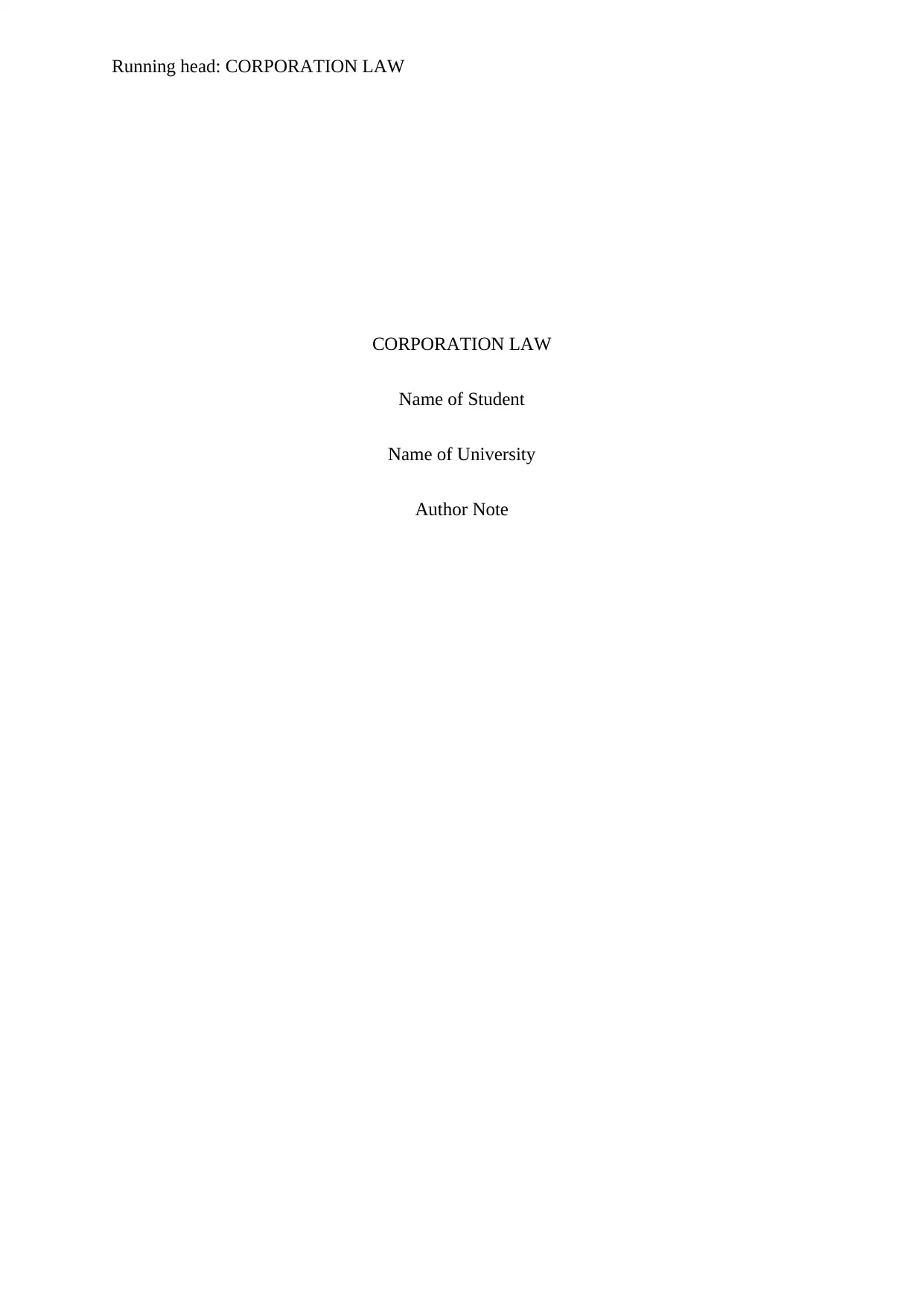
Running head: CORPORATION LAW
CORPORATION LAW
Name of Student
Name of University
Author Note
CORPORATION LAW
Name of Student
Name of University
Author Note
Paraphrase This Document
Need a fresh take? Get an instant paraphrase of this document with our AI Paraphraser
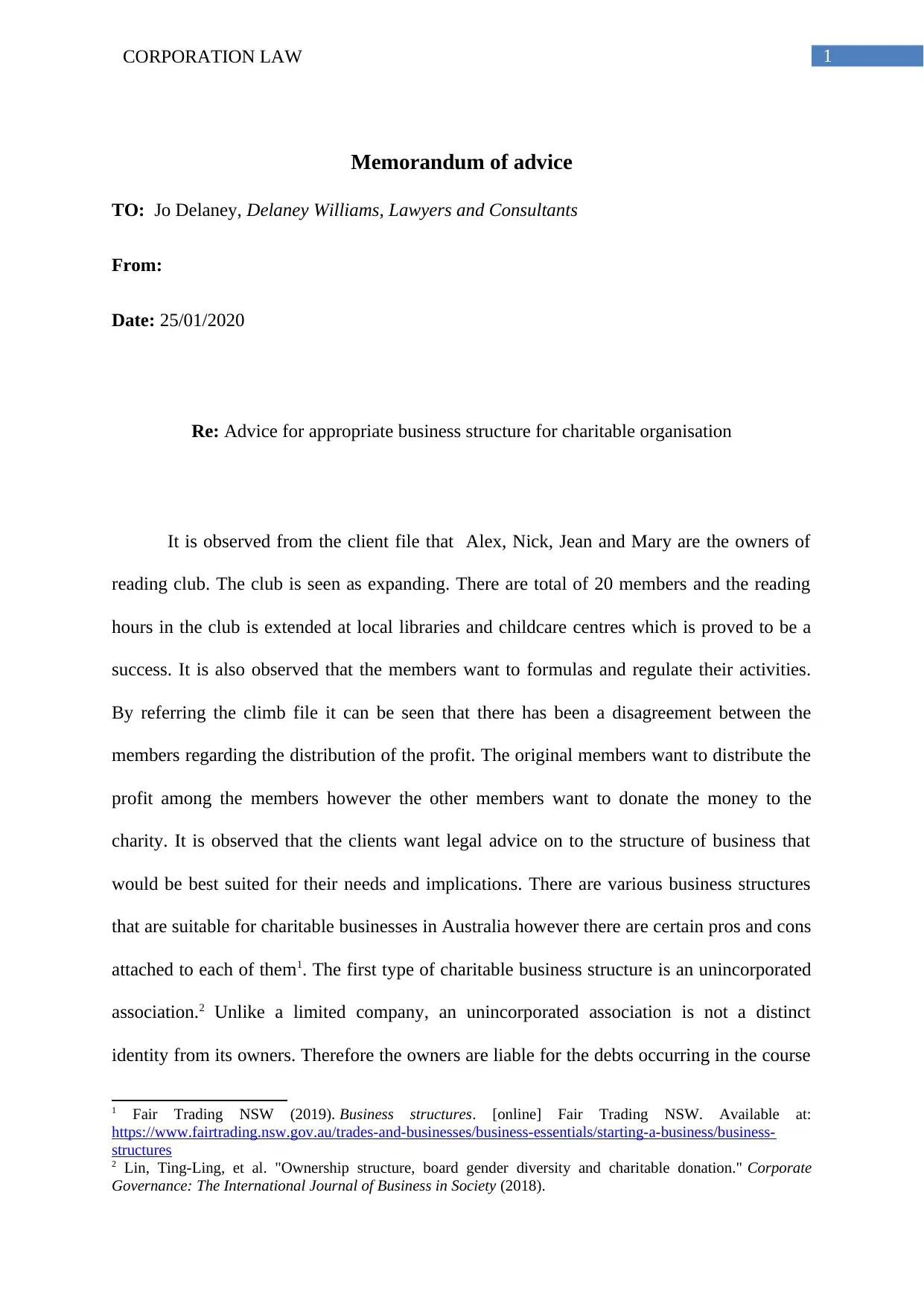
1CORPORATION LAW
Memorandum of advice
TO: Jo Delaney, Delaney Williams, Lawyers and Consultants
From:
Date: 25/01/2020
Re: Advice for appropriate business structure for charitable organisation
It is observed from the client file that Alex, Nick, Jean and Mary are the owners of
reading club. The club is seen as expanding. There are total of 20 members and the reading
hours in the club is extended at local libraries and childcare centres which is proved to be a
success. It is also observed that the members want to formulas and regulate their activities.
By referring the climb file it can be seen that there has been a disagreement between the
members regarding the distribution of the profit. The original members want to distribute the
profit among the members however the other members want to donate the money to the
charity. It is observed that the clients want legal advice on to the structure of business that
would be best suited for their needs and implications. There are various business structures
that are suitable for charitable businesses in Australia however there are certain pros and cons
attached to each of them1. The first type of charitable business structure is an unincorporated
association.2 Unlike a limited company, an unincorporated association is not a distinct
identity from its owners. Therefore the owners are liable for the debts occurring in the course
1 Fair Trading NSW (2019). Business structures. [online] Fair Trading NSW. Available at:
https://www.fairtrading.nsw.gov.au/trades-and-businesses/business-essentials/starting-a-business/business-
structures
2 Lin, Ting-Ling, et al. "Ownership structure, board gender diversity and charitable donation." Corporate
Governance: The International Journal of Business in Society (2018).
Memorandum of advice
TO: Jo Delaney, Delaney Williams, Lawyers and Consultants
From:
Date: 25/01/2020
Re: Advice for appropriate business structure for charitable organisation
It is observed from the client file that Alex, Nick, Jean and Mary are the owners of
reading club. The club is seen as expanding. There are total of 20 members and the reading
hours in the club is extended at local libraries and childcare centres which is proved to be a
success. It is also observed that the members want to formulas and regulate their activities.
By referring the climb file it can be seen that there has been a disagreement between the
members regarding the distribution of the profit. The original members want to distribute the
profit among the members however the other members want to donate the money to the
charity. It is observed that the clients want legal advice on to the structure of business that
would be best suited for their needs and implications. There are various business structures
that are suitable for charitable businesses in Australia however there are certain pros and cons
attached to each of them1. The first type of charitable business structure is an unincorporated
association.2 Unlike a limited company, an unincorporated association is not a distinct
identity from its owners. Therefore the owners are liable for the debts occurring in the course
1 Fair Trading NSW (2019). Business structures. [online] Fair Trading NSW. Available at:
https://www.fairtrading.nsw.gov.au/trades-and-businesses/business-essentials/starting-a-business/business-
structures
2 Lin, Ting-Ling, et al. "Ownership structure, board gender diversity and charitable donation." Corporate
Governance: The International Journal of Business in Society (2018).
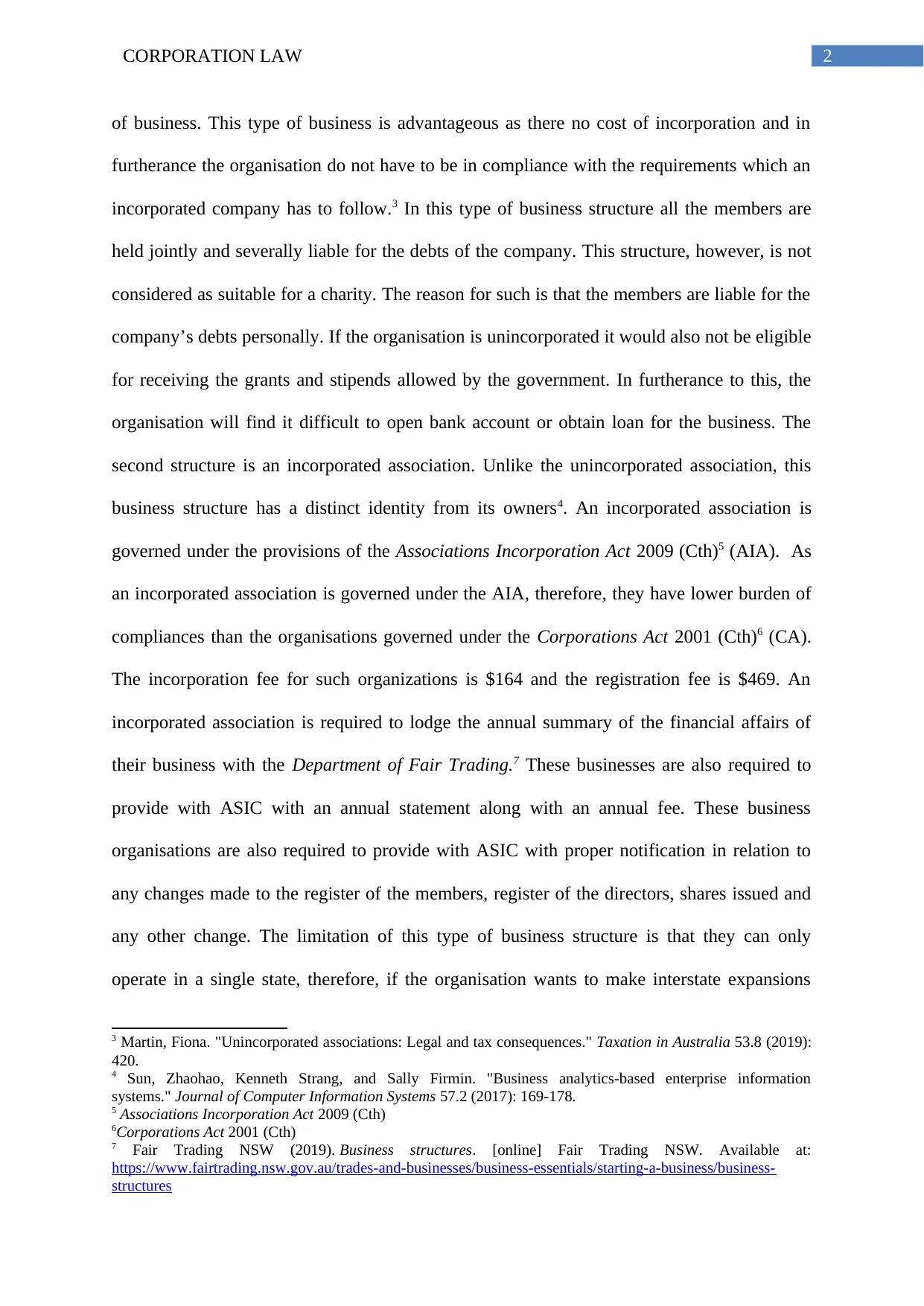
2CORPORATION LAW
of business. This type of business is advantageous as there no cost of incorporation and in
furtherance the organisation do not have to be in compliance with the requirements which an
incorporated company has to follow.3 In this type of business structure all the members are
held jointly and severally liable for the debts of the company. This structure, however, is not
considered as suitable for a charity. The reason for such is that the members are liable for the
company’s debts personally. If the organisation is unincorporated it would also not be eligible
for receiving the grants and stipends allowed by the government. In furtherance to this, the
organisation will find it difficult to open bank account or obtain loan for the business. The
second structure is an incorporated association. Unlike the unincorporated association, this
business structure has a distinct identity from its owners4. An incorporated association is
governed under the provisions of the Associations Incorporation Act 2009 (Cth)5 (AIA). As
an incorporated association is governed under the AIA, therefore, they have lower burden of
compliances than the organisations governed under the Corporations Act 2001 (Cth)6 (CA).
The incorporation fee for such organizations is $164 and the registration fee is $469. An
incorporated association is required to lodge the annual summary of the financial affairs of
their business with the Department of Fair Trading.7 These businesses are also required to
provide with ASIC with an annual statement along with an annual fee. These business
organisations are also required to provide with ASIC with proper notification in relation to
any changes made to the register of the members, register of the directors, shares issued and
any other change. The limitation of this type of business structure is that they can only
operate in a single state, therefore, if the organisation wants to make interstate expansions
3 Martin, Fiona. "Unincorporated associations: Legal and tax consequences." Taxation in Australia 53.8 (2019):
420.
4 Sun, Zhaohao, Kenneth Strang, and Sally Firmin. "Business analytics-based enterprise information
systems." Journal of Computer Information Systems 57.2 (2017): 169-178.
5 Associations Incorporation Act 2009 (Cth)
6Corporations Act 2001 (Cth)
7 Fair Trading NSW (2019). Business structures. [online] Fair Trading NSW. Available at:
https://www.fairtrading.nsw.gov.au/trades-and-businesses/business-essentials/starting-a-business/business-
structures
of business. This type of business is advantageous as there no cost of incorporation and in
furtherance the organisation do not have to be in compliance with the requirements which an
incorporated company has to follow.3 In this type of business structure all the members are
held jointly and severally liable for the debts of the company. This structure, however, is not
considered as suitable for a charity. The reason for such is that the members are liable for the
company’s debts personally. If the organisation is unincorporated it would also not be eligible
for receiving the grants and stipends allowed by the government. In furtherance to this, the
organisation will find it difficult to open bank account or obtain loan for the business. The
second structure is an incorporated association. Unlike the unincorporated association, this
business structure has a distinct identity from its owners4. An incorporated association is
governed under the provisions of the Associations Incorporation Act 2009 (Cth)5 (AIA). As
an incorporated association is governed under the AIA, therefore, they have lower burden of
compliances than the organisations governed under the Corporations Act 2001 (Cth)6 (CA).
The incorporation fee for such organizations is $164 and the registration fee is $469. An
incorporated association is required to lodge the annual summary of the financial affairs of
their business with the Department of Fair Trading.7 These businesses are also required to
provide with ASIC with an annual statement along with an annual fee. These business
organisations are also required to provide with ASIC with proper notification in relation to
any changes made to the register of the members, register of the directors, shares issued and
any other change. The limitation of this type of business structure is that they can only
operate in a single state, therefore, if the organisation wants to make interstate expansions
3 Martin, Fiona. "Unincorporated associations: Legal and tax consequences." Taxation in Australia 53.8 (2019):
420.
4 Sun, Zhaohao, Kenneth Strang, and Sally Firmin. "Business analytics-based enterprise information
systems." Journal of Computer Information Systems 57.2 (2017): 169-178.
5 Associations Incorporation Act 2009 (Cth)
6Corporations Act 2001 (Cth)
7 Fair Trading NSW (2019). Business structures. [online] Fair Trading NSW. Available at:
https://www.fairtrading.nsw.gov.au/trades-and-businesses/business-essentials/starting-a-business/business-
structures
⊘ This is a preview!⊘
Do you want full access?
Subscribe today to unlock all pages.

Trusted by 1+ million students worldwide
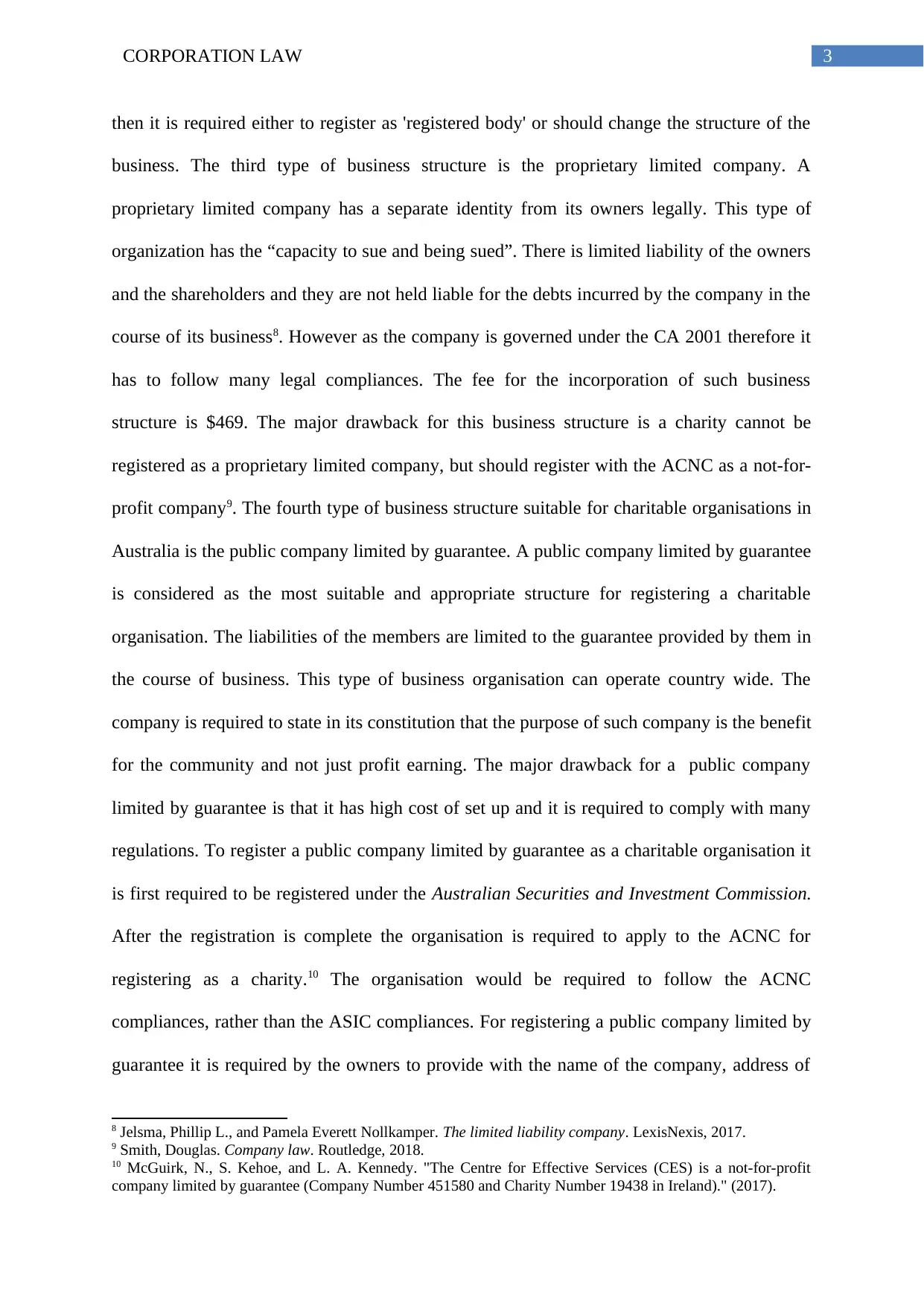
3CORPORATION LAW
then it is required either to register as 'registered body' or should change the structure of the
business. The third type of business structure is the proprietary limited company. A
proprietary limited company has a separate identity from its owners legally. This type of
organization has the “capacity to sue and being sued”. There is limited liability of the owners
and the shareholders and they are not held liable for the debts incurred by the company in the
course of its business8. However as the company is governed under the CA 2001 therefore it
has to follow many legal compliances. The fee for the incorporation of such business
structure is $469. The major drawback for this business structure is a charity cannot be
registered as a proprietary limited company, but should register with the ACNC as a not-for-
profit company9. The fourth type of business structure suitable for charitable organisations in
Australia is the public company limited by guarantee. A public company limited by guarantee
is considered as the most suitable and appropriate structure for registering a charitable
organisation. The liabilities of the members are limited to the guarantee provided by them in
the course of business. This type of business organisation can operate country wide. The
company is required to state in its constitution that the purpose of such company is the benefit
for the community and not just profit earning. The major drawback for a public company
limited by guarantee is that it has high cost of set up and it is required to comply with many
regulations. To register a public company limited by guarantee as a charitable organisation it
is first required to be registered under the Australian Securities and Investment Commission.
After the registration is complete the organisation is required to apply to the ACNC for
registering as a charity.10 The organisation would be required to follow the ACNC
compliances, rather than the ASIC compliances. For registering a public company limited by
guarantee it is required by the owners to provide with the name of the company, address of
8 Jelsma, Phillip L., and Pamela Everett Nollkamper. The limited liability company. LexisNexis, 2017.
9 Smith, Douglas. Company law. Routledge, 2018.
10 McGuirk, N., S. Kehoe, and L. A. Kennedy. "The Centre for Effective Services (CES) is a not-for-profit
company limited by guarantee (Company Number 451580 and Charity Number 19438 in Ireland)." (2017).
then it is required either to register as 'registered body' or should change the structure of the
business. The third type of business structure is the proprietary limited company. A
proprietary limited company has a separate identity from its owners legally. This type of
organization has the “capacity to sue and being sued”. There is limited liability of the owners
and the shareholders and they are not held liable for the debts incurred by the company in the
course of its business8. However as the company is governed under the CA 2001 therefore it
has to follow many legal compliances. The fee for the incorporation of such business
structure is $469. The major drawback for this business structure is a charity cannot be
registered as a proprietary limited company, but should register with the ACNC as a not-for-
profit company9. The fourth type of business structure suitable for charitable organisations in
Australia is the public company limited by guarantee. A public company limited by guarantee
is considered as the most suitable and appropriate structure for registering a charitable
organisation. The liabilities of the members are limited to the guarantee provided by them in
the course of business. This type of business organisation can operate country wide. The
company is required to state in its constitution that the purpose of such company is the benefit
for the community and not just profit earning. The major drawback for a public company
limited by guarantee is that it has high cost of set up and it is required to comply with many
regulations. To register a public company limited by guarantee as a charitable organisation it
is first required to be registered under the Australian Securities and Investment Commission.
After the registration is complete the organisation is required to apply to the ACNC for
registering as a charity.10 The organisation would be required to follow the ACNC
compliances, rather than the ASIC compliances. For registering a public company limited by
guarantee it is required by the owners to provide with the name of the company, address of
8 Jelsma, Phillip L., and Pamela Everett Nollkamper. The limited liability company. LexisNexis, 2017.
9 Smith, Douglas. Company law. Routledge, 2018.
10 McGuirk, N., S. Kehoe, and L. A. Kennedy. "The Centre for Effective Services (CES) is a not-for-profit
company limited by guarantee (Company Number 451580 and Charity Number 19438 in Ireland)." (2017).
Paraphrase This Document
Need a fresh take? Get an instant paraphrase of this document with our AI Paraphraser
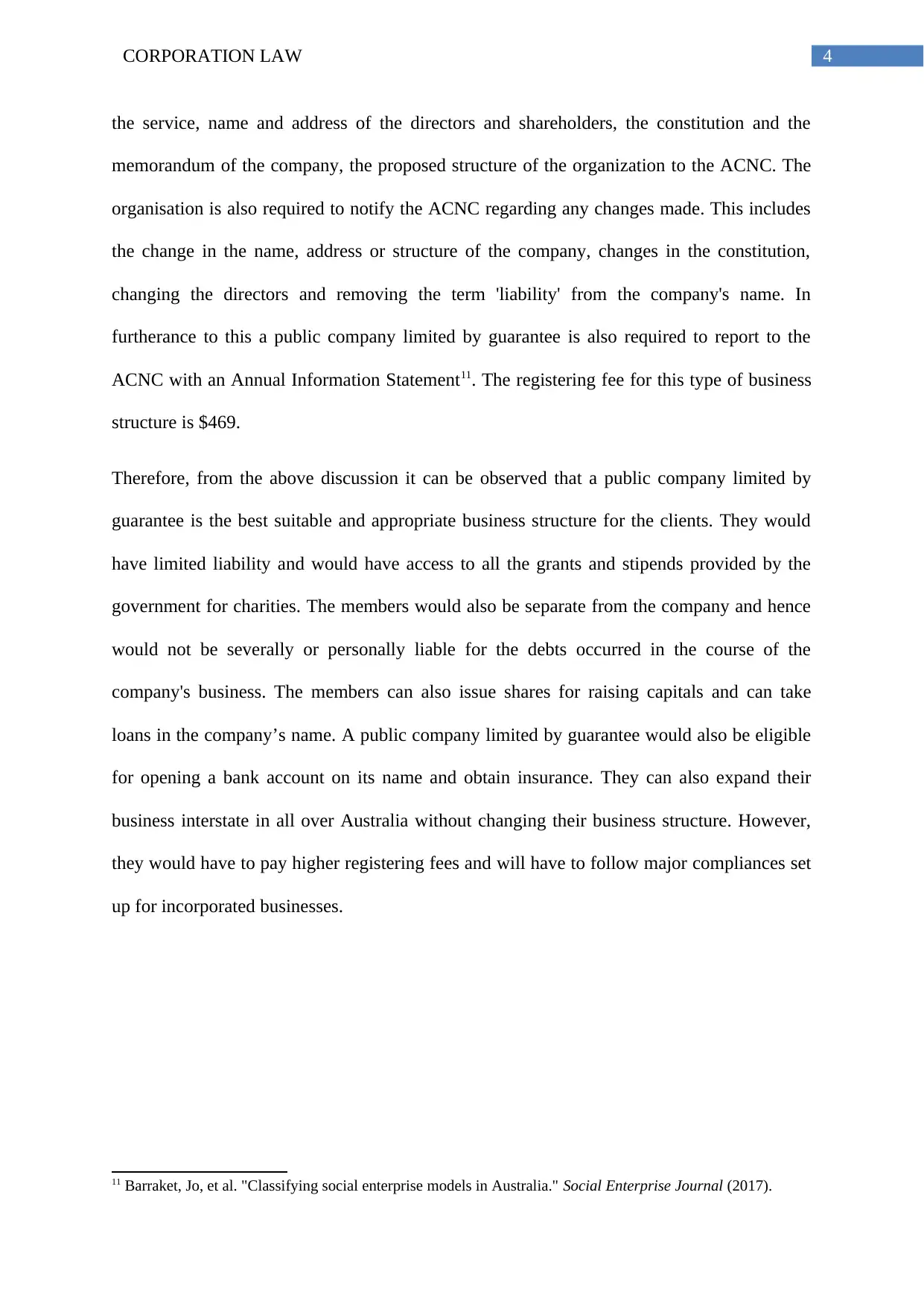
4CORPORATION LAW
the service, name and address of the directors and shareholders, the constitution and the
memorandum of the company, the proposed structure of the organization to the ACNC. The
organisation is also required to notify the ACNC regarding any changes made. This includes
the change in the name, address or structure of the company, changes in the constitution,
changing the directors and removing the term 'liability' from the company's name. In
furtherance to this a public company limited by guarantee is also required to report to the
ACNC with an Annual Information Statement11. The registering fee for this type of business
structure is $469.
Therefore, from the above discussion it can be observed that a public company limited by
guarantee is the best suitable and appropriate business structure for the clients. They would
have limited liability and would have access to all the grants and stipends provided by the
government for charities. The members would also be separate from the company and hence
would not be severally or personally liable for the debts occurred in the course of the
company's business. The members can also issue shares for raising capitals and can take
loans in the company’s name. A public company limited by guarantee would also be eligible
for opening a bank account on its name and obtain insurance. They can also expand their
business interstate in all over Australia without changing their business structure. However,
they would have to pay higher registering fees and will have to follow major compliances set
up for incorporated businesses.
11 Barraket, Jo, et al. "Classifying social enterprise models in Australia." Social Enterprise Journal (2017).
the service, name and address of the directors and shareholders, the constitution and the
memorandum of the company, the proposed structure of the organization to the ACNC. The
organisation is also required to notify the ACNC regarding any changes made. This includes
the change in the name, address or structure of the company, changes in the constitution,
changing the directors and removing the term 'liability' from the company's name. In
furtherance to this a public company limited by guarantee is also required to report to the
ACNC with an Annual Information Statement11. The registering fee for this type of business
structure is $469.
Therefore, from the above discussion it can be observed that a public company limited by
guarantee is the best suitable and appropriate business structure for the clients. They would
have limited liability and would have access to all the grants and stipends provided by the
government for charities. The members would also be separate from the company and hence
would not be severally or personally liable for the debts occurred in the course of the
company's business. The members can also issue shares for raising capitals and can take
loans in the company’s name. A public company limited by guarantee would also be eligible
for opening a bank account on its name and obtain insurance. They can also expand their
business interstate in all over Australia without changing their business structure. However,
they would have to pay higher registering fees and will have to follow major compliances set
up for incorporated businesses.
11 Barraket, Jo, et al. "Classifying social enterprise models in Australia." Social Enterprise Journal (2017).
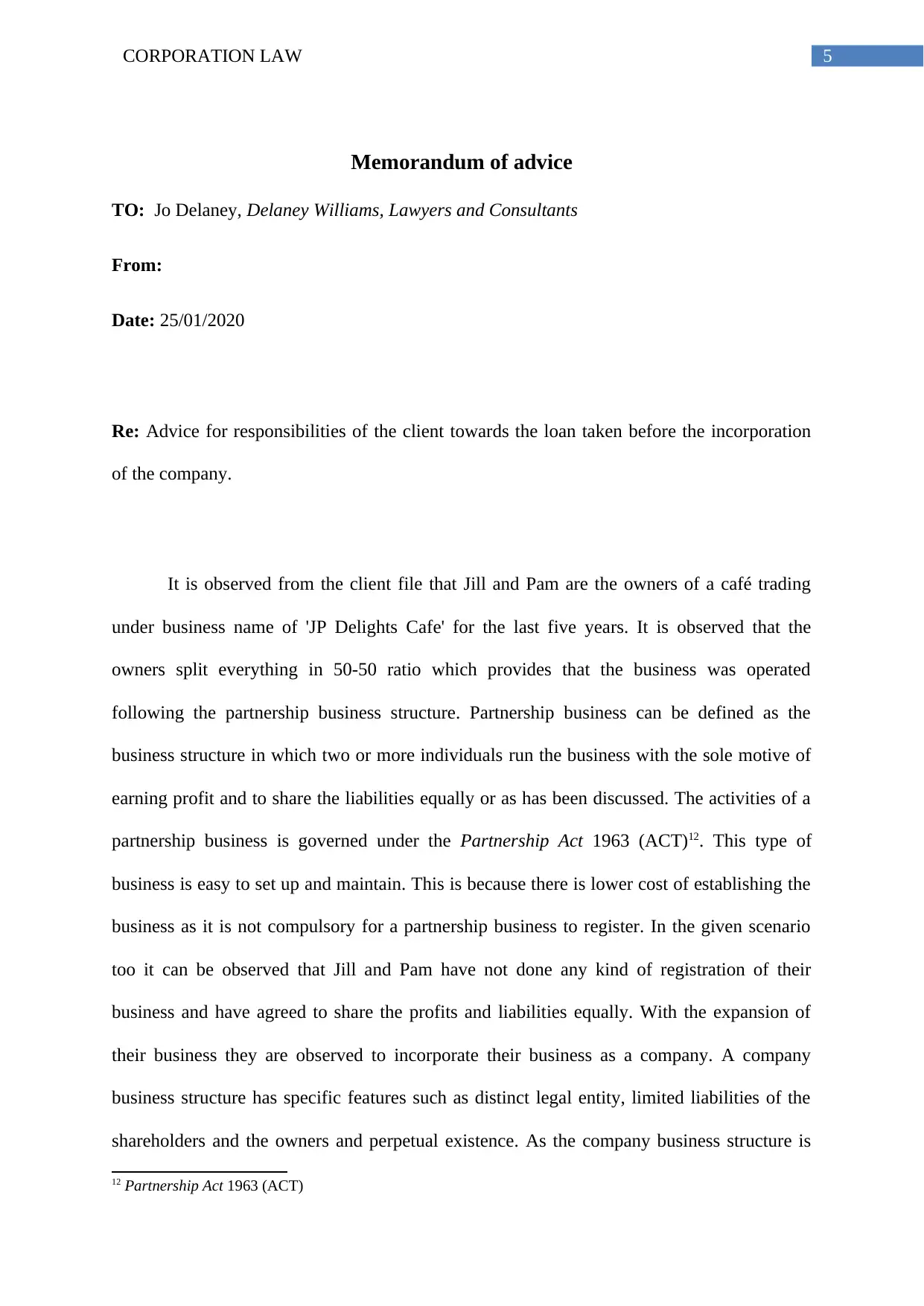
5CORPORATION LAW
Memorandum of advice
TO: Jo Delaney, Delaney Williams, Lawyers and Consultants
From:
Date: 25/01/2020
Re: Advice for responsibilities of the client towards the loan taken before the incorporation
of the company.
It is observed from the client file that Jill and Pam are the owners of a café trading
under business name of 'JP Delights Cafe' for the last five years. It is observed that the
owners split everything in 50-50 ratio which provides that the business was operated
following the partnership business structure. Partnership business can be defined as the
business structure in which two or more individuals run the business with the sole motive of
earning profit and to share the liabilities equally or as has been discussed. The activities of a
partnership business is governed under the Partnership Act 1963 (ACT)12. This type of
business is easy to set up and maintain. This is because there is lower cost of establishing the
business as it is not compulsory for a partnership business to register. In the given scenario
too it can be observed that Jill and Pam have not done any kind of registration of their
business and have agreed to share the profits and liabilities equally. With the expansion of
their business they are observed to incorporate their business as a company. A company
business structure has specific features such as distinct legal entity, limited liabilities of the
shareholders and the owners and perpetual existence. As the company business structure is
12 Partnership Act 1963 (ACT)
Memorandum of advice
TO: Jo Delaney, Delaney Williams, Lawyers and Consultants
From:
Date: 25/01/2020
Re: Advice for responsibilities of the client towards the loan taken before the incorporation
of the company.
It is observed from the client file that Jill and Pam are the owners of a café trading
under business name of 'JP Delights Cafe' for the last five years. It is observed that the
owners split everything in 50-50 ratio which provides that the business was operated
following the partnership business structure. Partnership business can be defined as the
business structure in which two or more individuals run the business with the sole motive of
earning profit and to share the liabilities equally or as has been discussed. The activities of a
partnership business is governed under the Partnership Act 1963 (ACT)12. This type of
business is easy to set up and maintain. This is because there is lower cost of establishing the
business as it is not compulsory for a partnership business to register. In the given scenario
too it can be observed that Jill and Pam have not done any kind of registration of their
business and have agreed to share the profits and liabilities equally. With the expansion of
their business they are observed to incorporate their business as a company. A company
business structure has specific features such as distinct legal entity, limited liabilities of the
shareholders and the owners and perpetual existence. As the company business structure is
12 Partnership Act 1963 (ACT)
⊘ This is a preview!⊘
Do you want full access?
Subscribe today to unlock all pages.

Trusted by 1+ million students worldwide
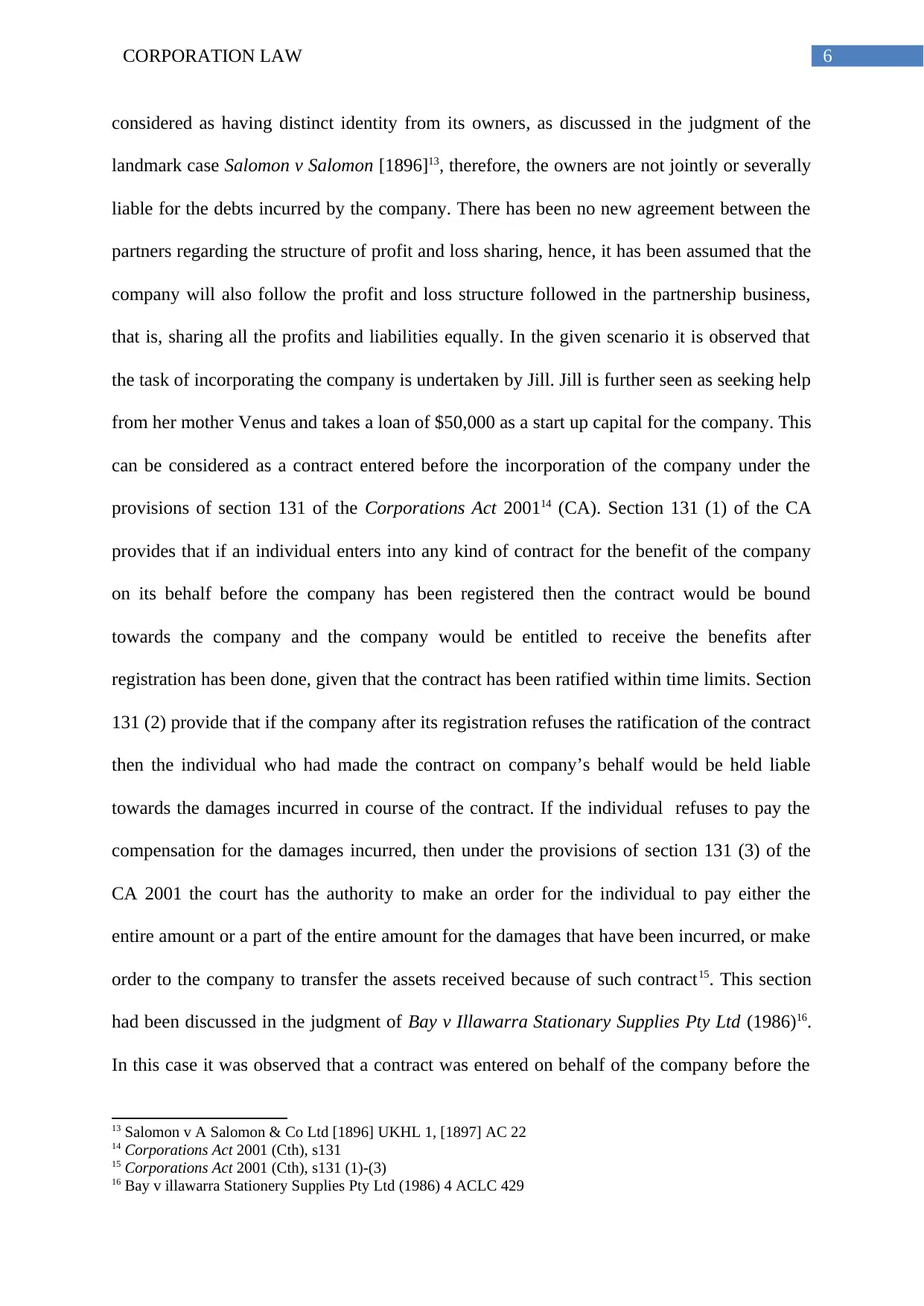
6CORPORATION LAW
considered as having distinct identity from its owners, as discussed in the judgment of the
landmark case Salomon v Salomon [1896]13, therefore, the owners are not jointly or severally
liable for the debts incurred by the company. There has been no new agreement between the
partners regarding the structure of profit and loss sharing, hence, it has been assumed that the
company will also follow the profit and loss structure followed in the partnership business,
that is, sharing all the profits and liabilities equally. In the given scenario it is observed that
the task of incorporating the company is undertaken by Jill. Jill is further seen as seeking help
from her mother Venus and takes a loan of $50,000 as a start up capital for the company. This
can be considered as a contract entered before the incorporation of the company under the
provisions of section 131 of the Corporations Act 200114 (CA). Section 131 (1) of the CA
provides that if an individual enters into any kind of contract for the benefit of the company
on its behalf before the company has been registered then the contract would be bound
towards the company and the company would be entitled to receive the benefits after
registration has been done, given that the contract has been ratified within time limits. Section
131 (2) provide that if the company after its registration refuses the ratification of the contract
then the individual who had made the contract on company’s behalf would be held liable
towards the damages incurred in course of the contract. If the individual refuses to pay the
compensation for the damages incurred, then under the provisions of section 131 (3) of the
CA 2001 the court has the authority to make an order for the individual to pay either the
entire amount or a part of the entire amount for the damages that have been incurred, or make
order to the company to transfer the assets received because of such contract15. This section
had been discussed in the judgment of Bay v Illawarra Stationary Supplies Pty Ltd (1986)16.
In this case it was observed that a contract was entered on behalf of the company before the
13 Salomon v A Salomon & Co Ltd [1896] UKHL 1, [1897] AC 22
14 Corporations Act 2001 (Cth), s131
15 Corporations Act 2001 (Cth), s131 (1)-(3)
16 Bay v illawarra Stationery Supplies Pty Ltd (1986) 4 ACLC 429
considered as having distinct identity from its owners, as discussed in the judgment of the
landmark case Salomon v Salomon [1896]13, therefore, the owners are not jointly or severally
liable for the debts incurred by the company. There has been no new agreement between the
partners regarding the structure of profit and loss sharing, hence, it has been assumed that the
company will also follow the profit and loss structure followed in the partnership business,
that is, sharing all the profits and liabilities equally. In the given scenario it is observed that
the task of incorporating the company is undertaken by Jill. Jill is further seen as seeking help
from her mother Venus and takes a loan of $50,000 as a start up capital for the company. This
can be considered as a contract entered before the incorporation of the company under the
provisions of section 131 of the Corporations Act 200114 (CA). Section 131 (1) of the CA
provides that if an individual enters into any kind of contract for the benefit of the company
on its behalf before the company has been registered then the contract would be bound
towards the company and the company would be entitled to receive the benefits after
registration has been done, given that the contract has been ratified within time limits. Section
131 (2) provide that if the company after its registration refuses the ratification of the contract
then the individual who had made the contract on company’s behalf would be held liable
towards the damages incurred in course of the contract. If the individual refuses to pay the
compensation for the damages incurred, then under the provisions of section 131 (3) of the
CA 2001 the court has the authority to make an order for the individual to pay either the
entire amount or a part of the entire amount for the damages that have been incurred, or make
order to the company to transfer the assets received because of such contract15. This section
had been discussed in the judgment of Bay v Illawarra Stationary Supplies Pty Ltd (1986)16.
In this case it was observed that a contract was entered on behalf of the company before the
13 Salomon v A Salomon & Co Ltd [1896] UKHL 1, [1897] AC 22
14 Corporations Act 2001 (Cth), s131
15 Corporations Act 2001 (Cth), s131 (1)-(3)
16 Bay v illawarra Stationery Supplies Pty Ltd (1986) 4 ACLC 429
Paraphrase This Document
Need a fresh take? Get an instant paraphrase of this document with our AI Paraphraser
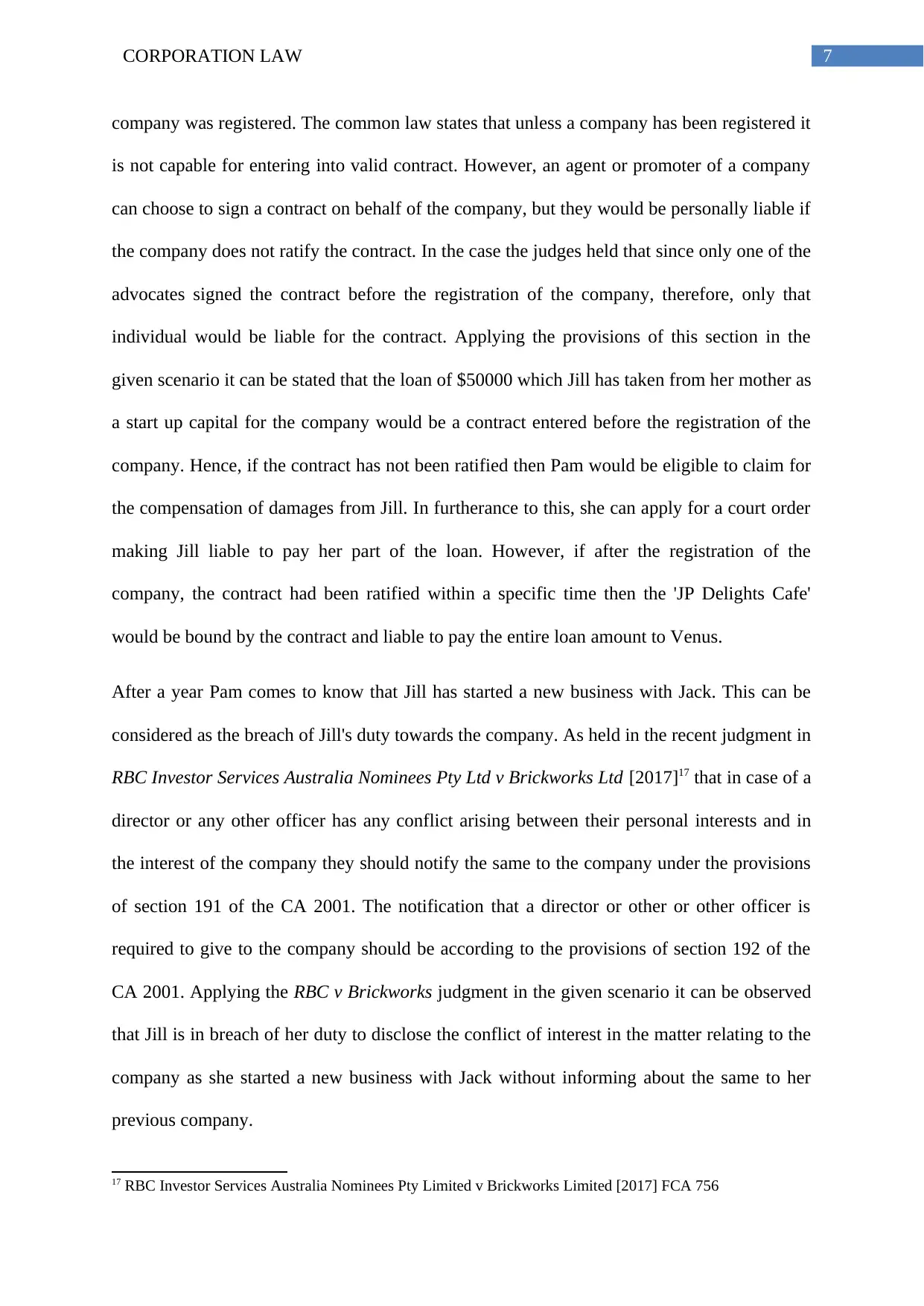
7CORPORATION LAW
company was registered. The common law states that unless a company has been registered it
is not capable for entering into valid contract. However, an agent or promoter of a company
can choose to sign a contract on behalf of the company, but they would be personally liable if
the company does not ratify the contract. In the case the judges held that since only one of the
advocates signed the contract before the registration of the company, therefore, only that
individual would be liable for the contract. Applying the provisions of this section in the
given scenario it can be stated that the loan of $50000 which Jill has taken from her mother as
a start up capital for the company would be a contract entered before the registration of the
company. Hence, if the contract has not been ratified then Pam would be eligible to claim for
the compensation of damages from Jill. In furtherance to this, she can apply for a court order
making Jill liable to pay her part of the loan. However, if after the registration of the
company, the contract had been ratified within a specific time then the 'JP Delights Cafe'
would be bound by the contract and liable to pay the entire loan amount to Venus.
After a year Pam comes to know that Jill has started a new business with Jack. This can be
considered as the breach of Jill's duty towards the company. As held in the recent judgment in
RBC Investor Services Australia Nominees Pty Ltd v Brickworks Ltd [2017]17 that in case of a
director or any other officer has any conflict arising between their personal interests and in
the interest of the company they should notify the same to the company under the provisions
of section 191 of the CA 2001. The notification that a director or other or other officer is
required to give to the company should be according to the provisions of section 192 of the
CA 2001. Applying the RBC v Brickworks judgment in the given scenario it can be observed
that Jill is in breach of her duty to disclose the conflict of interest in the matter relating to the
company as she started a new business with Jack without informing about the same to her
previous company.
17 RBC Investor Services Australia Nominees Pty Limited v Brickworks Limited [2017] FCA 756
company was registered. The common law states that unless a company has been registered it
is not capable for entering into valid contract. However, an agent or promoter of a company
can choose to sign a contract on behalf of the company, but they would be personally liable if
the company does not ratify the contract. In the case the judges held that since only one of the
advocates signed the contract before the registration of the company, therefore, only that
individual would be liable for the contract. Applying the provisions of this section in the
given scenario it can be stated that the loan of $50000 which Jill has taken from her mother as
a start up capital for the company would be a contract entered before the registration of the
company. Hence, if the contract has not been ratified then Pam would be eligible to claim for
the compensation of damages from Jill. In furtherance to this, she can apply for a court order
making Jill liable to pay her part of the loan. However, if after the registration of the
company, the contract had been ratified within a specific time then the 'JP Delights Cafe'
would be bound by the contract and liable to pay the entire loan amount to Venus.
After a year Pam comes to know that Jill has started a new business with Jack. This can be
considered as the breach of Jill's duty towards the company. As held in the recent judgment in
RBC Investor Services Australia Nominees Pty Ltd v Brickworks Ltd [2017]17 that in case of a
director or any other officer has any conflict arising between their personal interests and in
the interest of the company they should notify the same to the company under the provisions
of section 191 of the CA 2001. The notification that a director or other or other officer is
required to give to the company should be according to the provisions of section 192 of the
CA 2001. Applying the RBC v Brickworks judgment in the given scenario it can be observed
that Jill is in breach of her duty to disclose the conflict of interest in the matter relating to the
company as she started a new business with Jack without informing about the same to her
previous company.
17 RBC Investor Services Australia Nominees Pty Limited v Brickworks Limited [2017] FCA 756
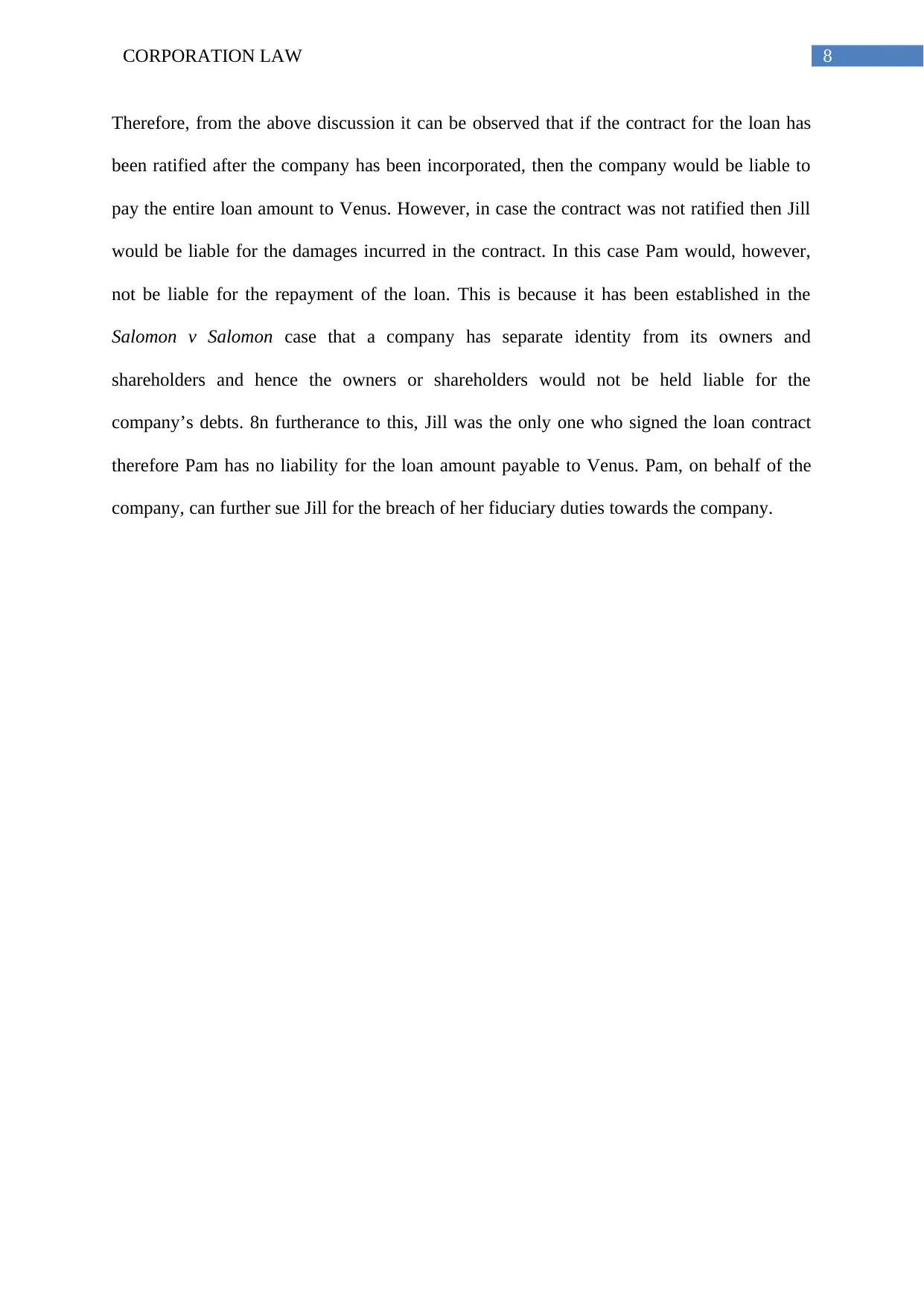
8CORPORATION LAW
Therefore, from the above discussion it can be observed that if the contract for the loan has
been ratified after the company has been incorporated, then the company would be liable to
pay the entire loan amount to Venus. However, in case the contract was not ratified then Jill
would be liable for the damages incurred in the contract. In this case Pam would, however,
not be liable for the repayment of the loan. This is because it has been established in the
Salomon v Salomon case that a company has separate identity from its owners and
shareholders and hence the owners or shareholders would not be held liable for the
company’s debts. 8n furtherance to this, Jill was the only one who signed the loan contract
therefore Pam has no liability for the loan amount payable to Venus. Pam, on behalf of the
company, can further sue Jill for the breach of her fiduciary duties towards the company.
Therefore, from the above discussion it can be observed that if the contract for the loan has
been ratified after the company has been incorporated, then the company would be liable to
pay the entire loan amount to Venus. However, in case the contract was not ratified then Jill
would be liable for the damages incurred in the contract. In this case Pam would, however,
not be liable for the repayment of the loan. This is because it has been established in the
Salomon v Salomon case that a company has separate identity from its owners and
shareholders and hence the owners or shareholders would not be held liable for the
company’s debts. 8n furtherance to this, Jill was the only one who signed the loan contract
therefore Pam has no liability for the loan amount payable to Venus. Pam, on behalf of the
company, can further sue Jill for the breach of her fiduciary duties towards the company.
⊘ This is a preview!⊘
Do you want full access?
Subscribe today to unlock all pages.

Trusted by 1+ million students worldwide
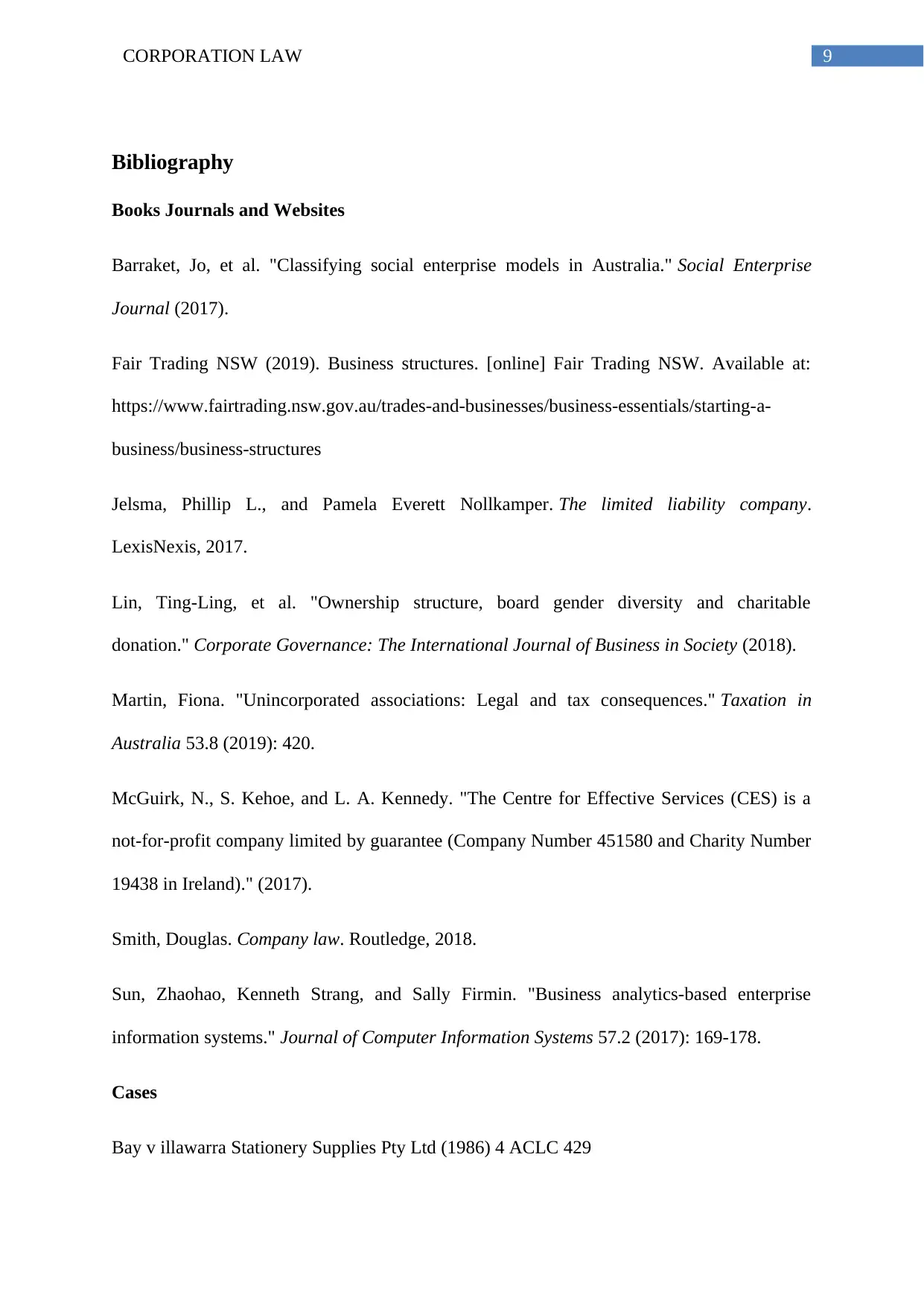
9CORPORATION LAW
Bibliography
Books Journals and Websites
Barraket, Jo, et al. "Classifying social enterprise models in Australia." Social Enterprise
Journal (2017).
Fair Trading NSW (2019). Business structures. [online] Fair Trading NSW. Available at:
https://www.fairtrading.nsw.gov.au/trades-and-businesses/business-essentials/starting-a-
business/business-structures
Jelsma, Phillip L., and Pamela Everett Nollkamper. The limited liability company.
LexisNexis, 2017.
Lin, Ting-Ling, et al. "Ownership structure, board gender diversity and charitable
donation." Corporate Governance: The International Journal of Business in Society (2018).
Martin, Fiona. "Unincorporated associations: Legal and tax consequences." Taxation in
Australia 53.8 (2019): 420.
McGuirk, N., S. Kehoe, and L. A. Kennedy. "The Centre for Effective Services (CES) is a
not-for-profit company limited by guarantee (Company Number 451580 and Charity Number
19438 in Ireland)." (2017).
Smith, Douglas. Company law. Routledge, 2018.
Sun, Zhaohao, Kenneth Strang, and Sally Firmin. "Business analytics-based enterprise
information systems." Journal of Computer Information Systems 57.2 (2017): 169-178.
Cases
Bay v illawarra Stationery Supplies Pty Ltd (1986) 4 ACLC 429
Bibliography
Books Journals and Websites
Barraket, Jo, et al. "Classifying social enterprise models in Australia." Social Enterprise
Journal (2017).
Fair Trading NSW (2019). Business structures. [online] Fair Trading NSW. Available at:
https://www.fairtrading.nsw.gov.au/trades-and-businesses/business-essentials/starting-a-
business/business-structures
Jelsma, Phillip L., and Pamela Everett Nollkamper. The limited liability company.
LexisNexis, 2017.
Lin, Ting-Ling, et al. "Ownership structure, board gender diversity and charitable
donation." Corporate Governance: The International Journal of Business in Society (2018).
Martin, Fiona. "Unincorporated associations: Legal and tax consequences." Taxation in
Australia 53.8 (2019): 420.
McGuirk, N., S. Kehoe, and L. A. Kennedy. "The Centre for Effective Services (CES) is a
not-for-profit company limited by guarantee (Company Number 451580 and Charity Number
19438 in Ireland)." (2017).
Smith, Douglas. Company law. Routledge, 2018.
Sun, Zhaohao, Kenneth Strang, and Sally Firmin. "Business analytics-based enterprise
information systems." Journal of Computer Information Systems 57.2 (2017): 169-178.
Cases
Bay v illawarra Stationery Supplies Pty Ltd (1986) 4 ACLC 429
Paraphrase This Document
Need a fresh take? Get an instant paraphrase of this document with our AI Paraphraser
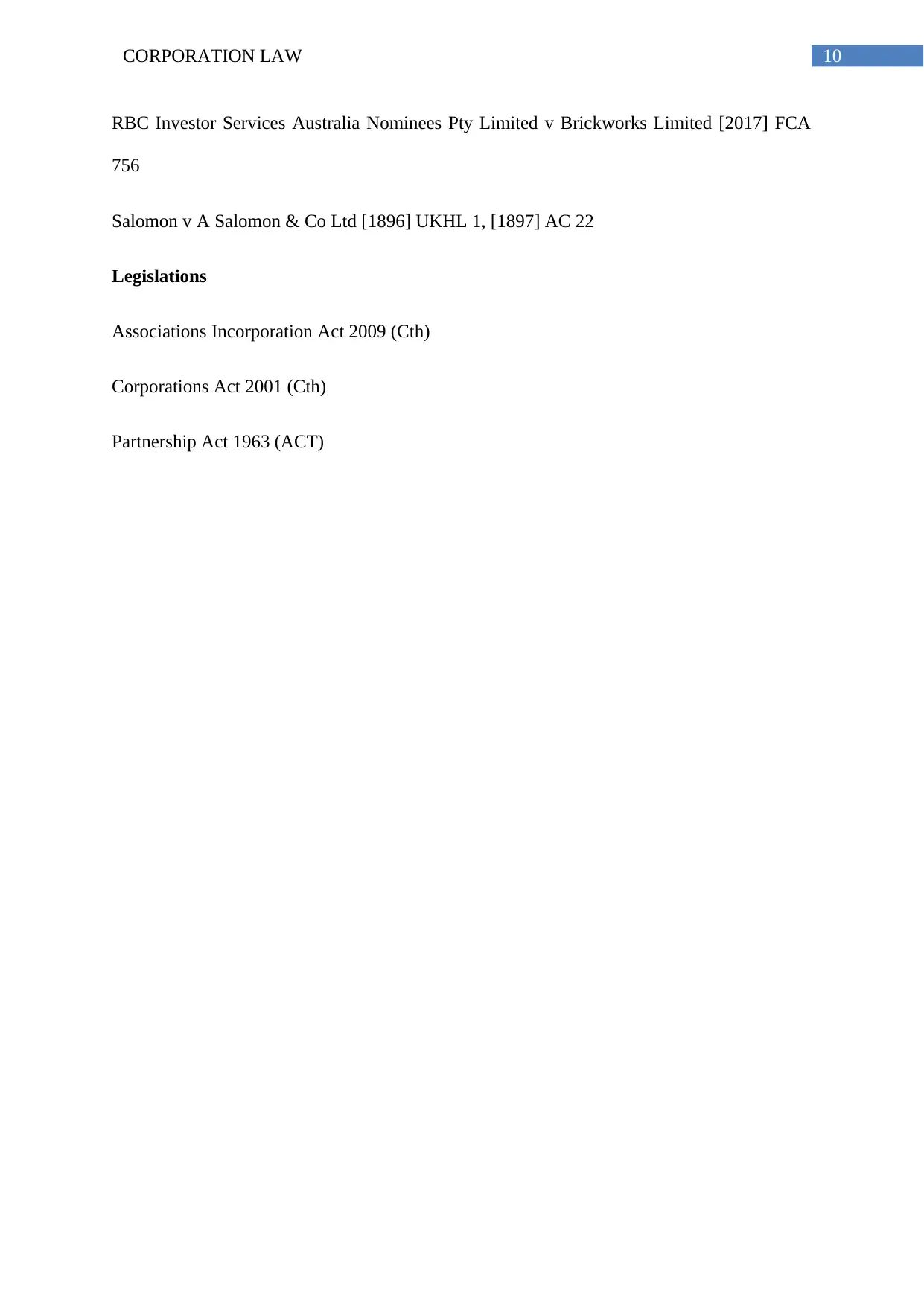
10CORPORATION LAW
RBC Investor Services Australia Nominees Pty Limited v Brickworks Limited [2017] FCA
756
Salomon v A Salomon & Co Ltd [1896] UKHL 1, [1897] AC 22
Legislations
Associations Incorporation Act 2009 (Cth)
Corporations Act 2001 (Cth)
Partnership Act 1963 (ACT)
RBC Investor Services Australia Nominees Pty Limited v Brickworks Limited [2017] FCA
756
Salomon v A Salomon & Co Ltd [1896] UKHL 1, [1897] AC 22
Legislations
Associations Incorporation Act 2009 (Cth)
Corporations Act 2001 (Cth)
Partnership Act 1963 (ACT)
1 out of 11
Related Documents
Your All-in-One AI-Powered Toolkit for Academic Success.
+13062052269
info@desklib.com
Available 24*7 on WhatsApp / Email
![[object Object]](/_next/static/media/star-bottom.7253800d.svg)
Unlock your academic potential
Copyright © 2020–2025 A2Z Services. All Rights Reserved. Developed and managed by ZUCOL.





